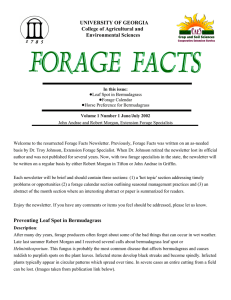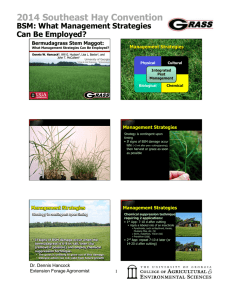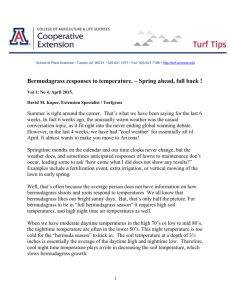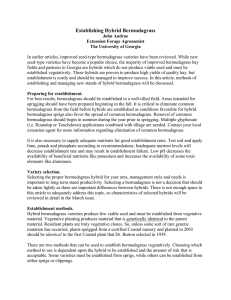Browning Bermuda: What’s going on in my field?
advertisement
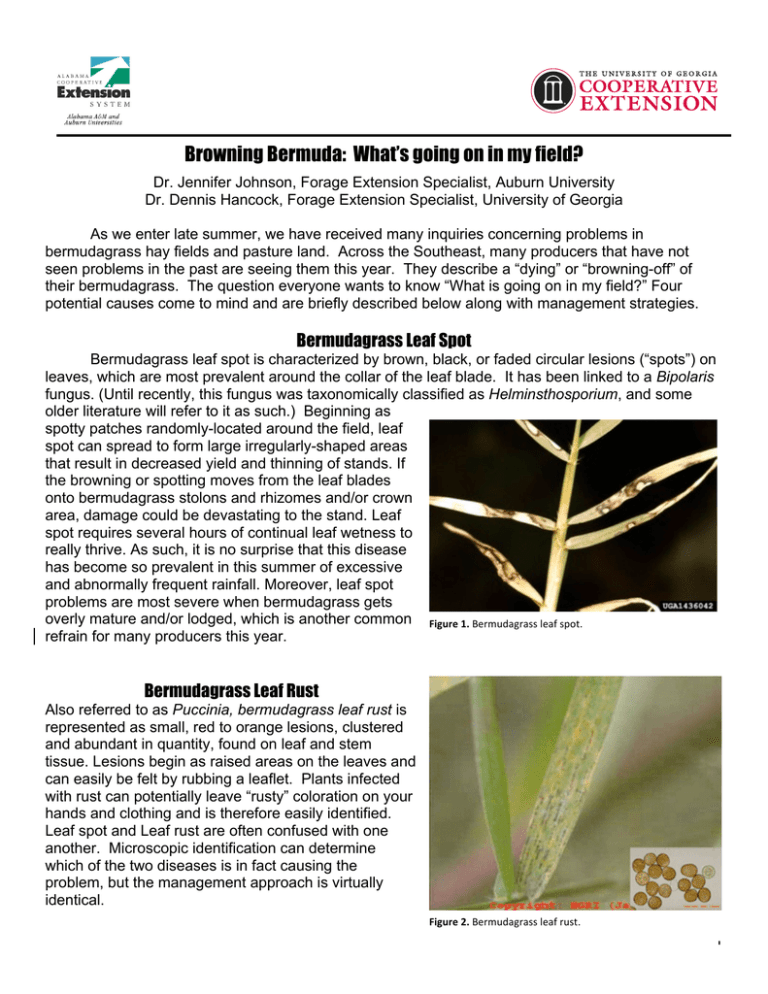
Browning Bermuda: What’s going on in my field? Dr. Jennifer Johnson, Forage Extension Specialist, Auburn University Dr. Dennis Hancock, Forage Extension Specialist, University of Georgia As we enter late summer, we have received many inquiries concerning problems in bermudagrass hay fields and pasture land. Across the Southeast, many producers that have not seen problems in the past are seeing them this year. They describe a “dying” or “browning-off” of their bermudagrass. The question everyone wants to know “What is going on in my field?” Four potential causes come to mind and are briefly described below along with management strategies. Bermudagrass Leaf Spot Bermudagrass leaf spot is characterized by brown, black, or faded circular lesions (“spots”) on leaves, which are most prevalent around the collar of the leaf blade. It has been linked to a Bipolaris fungus. (Until recently, this fungus was taxonomically classified as Helminsthosporium, and some older literature will refer to it as such.) Beginning as spotty patches randomly-located around the field, leaf spot can spread to form large irregularly-shaped areas that result in decreased yield and thinning of stands. If the browning or spotting moves from the leaf blades onto bermudagrass stolons and rhizomes and/or crown area, damage could be devastating to the stand. Leaf spot requires several hours of continual leaf wetness to really thrive. As such, it is no surprise that this disease has become so prevalent in this summer of excessive and abnormally frequent rainfall. Moreover, leaf spot problems are most severe when bermudagrass gets overly mature and/or lodged, which is another common Figure 1. Bermudagrass leaf spot. refrain for many producers this year. Bermudagrass Leaf Rust Also referred to as Puccinia, bermudagrass leaf rust is represented as small, red to orange lesions, clustered and abundant in quantity, found on leaf and stem tissue. Lesions begin as raised areas on the leaves and can easily be felt by rubbing a leaflet. Plants infected with rust can potentially leave “rusty” coloration on your hands and clothing and is therefore easily identified. Leaf spot and Leaf rust are often confused with one another. Microscopic identification can determine which of the two diseases is in fact causing the problem, but the management approach is virtually identical. Figure 2. Bermudagrass leaf rust. 1 Management: Bermudagrass varieties that are not as resistant as other varieties to these diseases can be the first problem. When preparing to establish new plantings of bermudagrass, select hybrid varieties (e.g., Tifton 85, Russell, Coastal, Tifton 44, etc.) that exhibit some level of disease resistance to decrease possible infection. Annually, most reports of leaf spot/rust are in common bermudagrass varieties or other varieties that are known to be susceptible (e.g., Alicia, World Feeder, etc.). This year, even resistant bermudagrass varieties are exhibiting significant signs of disease. Another important factor is soil fertility. Low soil potassium (K) levels in bermudagrass have been linked to increased disease and decreased stand. If soil tests do not recommend potash application and disease symptoms are still apparent, collect forage samples to determine potassium levels through tissue analysis. Other management considerations include timely harvest, minimized thatch, and water management. There are no chemical control options for leaf spot/rust. Regularly burning bermudagrass fields in late February or early March (at least 1 out of every 3 years) can drastically reduce the incidence of these disease problems because it reduces the residual forage that hosts the spores. Removing infected material and fertilizing to overcome nutrient deficiencies are currently the only options found to be effective to control leaf spot/rust. For more information about managing these disease problems in bermudagrass, see the UGA Cooperative Extension publication entitled “Leaf Spot Diagnosis and Management in Bermudagrass Forages” (C 887) at http://www.caes.uga.edu/Publications/pubDetail.cfm?pk_id=7386. Bermudagrass Stem Maggot The bermudagrass stem maggot is a new pest beginning to move quickly throughout the Southern region of the U.S. and readily affecting Alabama and Georgia. From afar, fields take on a Figure 3. Bermudagrass stem maggot damage to the tops of the plant. Control of the fly (left inset, with a dime for scale) is the current method for suppressing this pest problem. However, the damage is being done by the tiny larvae (right inset). 2 “frosted” appearance during mid-summer. When close up, the brown tips are readily seen. The damage is depicted as browning or death of leaves on the top parts of the shoot, the first two or three leaves. The remaining lower leaves of the plant typically remain green and unaffected. The affected shoot (upper leaves of the plant) stops elongation and dies due to feeding of the maggot at the shoot base. Plants may grow additional shoots in lower nodes to compensate for blocked elongation, but it should be noted that later generations of the maggot could attack the tips of these new shoots. When tugged lightly, the brown shoots should easily release from the green part of the plant, without much resistance. Management: A few methods are currently being utilized to combat damage imposed by infestations of the bermudagrass stem maggot. Depending on when infestations have been identified will determine your mode of action. If infestation is found within 1 week of normal harvest, initiate harvest as soon as weather conditions allow. If infestation is found between 1 and 3 weeks post-harvest, again harvest damaged material through mowing and possible baling to remove damaged material from the field, as soon as weather conditions allow. Suppression of the bermudagrass stem maggot flies can potentially be achieved through foliar applications of insecticide after cutting. Apply any labeled forage insecticide (for this insect, cheaper insecticides generally are just as effective as more expensive insecticides) shortly after harvest when new growth has been initiated (5-7 days), and repeat application 5 to 14 days later. This method is recommended for high infestations and when a yield decrease of 20% or greater is anticipated. For further information on this issue, refer to the Alabama Cooperative Extension System and UGA Cooperative Extension publication entitled “Biology and Management of the Bermudagrass Stem Maggot” at http://www.aces.edu/pubs/docs/A/ANR-1462/ANR-1462.pdf. Spittlebug Damage Spittlebugs are ubiquitous in most pastures and hayfields, though they typically do not result in economic losses. This year, there have been many reports and confirmed findings of two-lined spittlebug damage in bermudagrass hayfields and pastures. Most of this damage is relatively minor and is likely only occurring because the hay-making season has been so difficult. Both adults and nymphs suck juices from the grass with piercing-sucking mouthparts. Substantial amounts of plant sap are removed, and adults and nymphs surround themselves with a frothy spittle mass for protection. Adults are most active in early morning and hide near the soil surface during the heat of the day. Figure 4. Two-­‐line spittlebug. Figure 5. Spittlebug feeding on a cocklebur plant. 3 Management: The best control for spittlebugs is to maintain a timely harvest schedule. Stands that have been damaged should be harvested and affected forage should be removed. Using carbaryl (Sevin), lambda-cyhalothrin (Karate), or zeta-cypermethrin (Mustang Max) to control armyworms will also generally give helpful control of spittlebugs. For more information on this and other forage management subjects, check out our website at www.georgiaforages.com or contact your local University of Georgia Cooperative Extension office at 1-800-ASK-UGA1. The University of Georgia and Ft. Valley State University, the U.S. Department of Agriculture and counties of the state cooperating. Cooperative Extension, the University of Georgia College of Agricultural and Environmental Sciences, offers educational programs, assistance and materials to all people without regard to race, color, national origin, age, gender or disability. An Equal Opportunity Employer/Affirmative Action Organization Committed to a Diverse Work Force CSS-­‐F052 September 2013 Issued in furtherance of Cooperative Extension work, Acts of May 8 and June 30, 1914, The University of Georgia College of Agricultural and Environmental Sciences and the U.S. Department of Agriculture cooperating. J. Scott Angle, Dean and Director. 4
